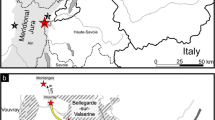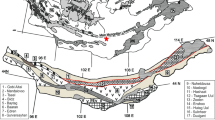Abstract
The Montalto Formation consists of a succession of slate, greywacke, quartzites, and polygenic conglomerates cropping out in the Dúrico-Beirã area of northern Portugal. The formation is of interest because it contains mixed volcaniclastic sequences that record changes in marginal-marine depositional environments and because it is associated with regional tectonic and magmatic processes. The Montalto Formation can be divided into three lithological associations that record a shallowing-upward sequence.
Access provided by Autonomous University of Puebla. Download conference paper PDF
Similar content being viewed by others
Keywords
Introduction
The Montalto Formation crops out west of the inverted limb and in the centre of the Valongo Anticline, northern Portugal. This formation is important because it lies at the unconformity between the Cambrian and the Ordovician, and the members within the formation fit with a regional picture of rock types including sandstones, conglomerates, pelites, greywackes, and volcanic rocks (rhyolites, dacites, and tuffs) that reflect repeated episodes of volcanism followed by volcaniclastic reworking during the middle–late Cambrian. The formation shows several stages of evolution related to the initial processes of sediment deposition followed by postdepositional metamorphism associated with the emplacement of Variscan granites. This resulted in a range of metamorphic signatures depending on the nature of the source rocks, and fluid migration along large strike-slip faults, which gave rise to vein mineralization in the region, including that related to gold–antimony deposits (Couto et al. 1990; Ribeiro et al. 2009).
Age and Stratigraphic Position
A schist–greywacke complex crops out in the Dúrico-Beirã area of northern Portugal (Medeiros et al. 1980). Here, the Valongo Anticline, a fold structure formed in the first phase of the Variscan orogeny, is an asymmetrical, NW–SE-trending anticline formed by lower Palaeozoic metasediments. The Montalto Formation lies directly underneath the unconformity that separates the Cambrian from the Lower Ordovician in northern Portugal, and crops out west of the inverse limb of the Valongo Anticline. Here, in outcrop, the formation is separated from lower Ordovician massive quartzites, locally with lenticular conglomerates at the base, by Carboniferous continental metasediments located within the Douro Shear Zone (Ribeiro et al. 2009). In the core of the anticline, the Montalto Formation is in contact with a lower Ordovician volcano–sedimentary succession of probable Tremadocian age. The succession exhibits a bimodal composition, with volcanoclastic rocks of rhyolitic affinities and basic volcanic rocks, indicating continental rifting at this time. The succession is in part correlative with the “Ollo de Sapo” Formation of the northeastern part of the Central Iberian Zone (Couto and Lourenço 2008). A middle Cambrian to basal Ordovician (Tremadoc) age has been proposed for the Montalto Formation (Couto 2011), which contrasts with a Floian age proposed by some authors (e.g., Sá et al. 2006), based on correlating the Montalto Formation with the Vale de Bojas Formation and with the Eucísia Formation (at Trás-os-Montes).
The Montalto Formation is underlain by the Terramonte Formation, a thick flyschoid succession that shows some turbiditic characteristics (Couto 1993), and which is considered equivalent to the metasediments of the lower to middle Cambrian Desejosa Formation (Sousa 1984) belonging to the Douro Group.
Lithology and Depositional Setting
The type section of the Montalto Formation was defined in the Montalto area, near Covelo (Gondomar) in formations generally designated as part of the schist–greywacke complex. Three distinct lithological associations are considered, and are used here in an informal rather than formal (Member) context (Couto 1993). These associations are described from bottom to top in turn below.
The lower lithological association is composed mainly of grey to violet slates and wackes with intercalations of weathered acid volcanic rocks and exhalites. Thin quartzitic layers interbedded with layers of abundant chlorite (Mg-ripidolite), abundant ilmenite, mica (paragonite and scarce pyrophyllite), angular quartz crystals, and sericite flakes resulting from feldspar alteration, are interpreted as exhalites (Couto 1993). Elsewhere, several-m-thick layers of green and violet to dark green laminated rocks, discretely foliated but more massive than the surrounding slates, are observed to have small yellowish to brownish spots (Fe- and Ti–Fe-oxides) with a matrix of sericite and subordinate carbonate and irregular layers of angular quartz crystals. These layers resulted from the recrystallization of a partly vitreous acid volcanic primary rock (Couto 1993).
The intermediate lithological association consists of interbedded successions of quartzite, wacke, and slate. Quartzites occur in metre-scale layers and are occasionally laminated (Fig. 1a). Within these quartzites, ichnofossils, namely Monocraterion are observed, which allows these rocks to be attributed to the Cambrian and confirms a shelf depositional setting (Couto et al. 1997). To the top of this lithological association, a laminated succession of grey to violet laminated slates and siltstones with kaolinite can be seen (Fig. 1b). Dykes of diabase are particularly common in this lithological association and variously interlayer with or cross-cut primary bedding.
The upper lithological association is composed mainly of conglomerate with slate, siltstone, quartzite, and wacke intercalations (Couto 1993). Conglomerates vary from clast- to matrix-supported (with a quartzitic, siltitic, or shaly matrix). Clasts are generally rounded, well sorted, and elongated or flattened (which may indicate postdepositional tectonic processes), with lengths ranging from a few to 10 cm. The clasts are typically composed of white quartz, with rare slate and lydite clasts in the centre of the succession (Fig. 2a). Towards the top of the succession, the conglomerate facies shows evidence of a polygenic origin, including clasts of different sizes and lithologies, suggesting reworking of bedrock basement by fluvial processes (Fig. 2b); this is consistent with regional patterns (Ribeiro et al. 2009) and suggests that the Montalto Formation is a shallowing-upward sequence related to regional-scale tectonism.
References
Couto, H. (1993). As mineralizações de Sb–Au da região Dúrico-Beirã. 2 Vols. (Vol. Texto; Vol. Anexos: 32 Estampas e 7 Mapas). PhD thesis, University of Porto (Unpublished). p. 60.
Couto, H. (2011). Montalto formation: A middle cambrian to basal Ordovician sequence in Dúrico-Beirã area (Northern Portugal). Mineralogical Magazine, 75(3), 700. June 2011. Goldschmidt Abstracts. 07c/2014/Mo.
Couto, H., & Lourenço, A. (2008). Cambrian–Ordovician transition in Valongo Anticline: Evidences of a continental rift in a Gondwana passive margin. In 33rd International Geological Congress Oslo, (Norway. SES-07 Dynamics of sedimentary basins. Abstract CD-Rom).
Couto, H., Piçarra, J. M., & Gutiérrez-Marco, J. C. (1997). El Paleozoico del Anticlinal de Valongo (Portugal). In A. Grandal d’Anglade, J. C. Gutiérrez-Marco, L. Santos Fidalgo (Eds.), XIII Jornadas de Paleontologia “Fósiles de Galicia” y V Reunión International Proyecto 351 PICG “Paleozoico Inferior del Noroeste de Gondwana”, A Coruna, Libro de Resúmenes y Excursiones, Sociedad Española de Paleontologia, Madrid, pp. 270–290.
Couto, H., Roger, G., Moëlo, Y., & Bril, H. (1990). Le district à antimoine-or Dúrico-Beirão (Portugal): évolution paragénétique et géochimique; implications métallogéniques. Mineralium Deposita,25, 69–81.
Medeiros, A. C., Pereira, E., & Moreira, A. (1980). Carta geológica de Portugal na escala de 1/50.000. Notícia explicativa da folha 9-D (Penafiel). Serviços Geológicos de Portugal, 46 p.
Ribeiro, A., Munhá, J., Mateus, A., Fonseca, P., Pereira, E., Noronha, F., et al. (2009). Mechanics of thick-skinned Variscan overprinting of Cadomian basement (Iberian Variscides). Comptes Rendus Geoscience,341, 127–139.
Sá A. A., Meireles, C., Gutiérrez-Marco, J. C., & Coke, C. (2006). A sucessão de Ordovícico Superior de Trás-os-Montes (Zona Centro-Ibérica, Portugal) e sua correlação com Valongo e Buçaco. In J. Mirão & A. Balbino (Coords.), Resumos alargados VII Congresso Nacional de Geologia, Évora 2, (pp. 621–624).
Sousa, B. (1984). Considerações sobre a estratigrafia do Complexo Xisto-Grauváquico (CXG) e a sua relação com o Paleozóico Inferior. Cuadernos Geologia Ibérica,9, 9–36.
Author information
Authors and Affiliations
Corresponding author
Editor information
Editors and Affiliations
Rights and permissions
Copyright information
© 2014 Springer-Verlag Berlin Heidelberg
About this paper
Cite this paper
Couto, H., Knight, J. (2014). The Montalto Formation: A Pre- to Basal Ordovician Succession in the Dúrico-Beirã Area (Northern Portugal). In: Rocha, R., Pais, J., Kullberg, J., Finney, S. (eds) STRATI 2013. Springer Geology. Springer, Cham. https://doi.org/10.1007/978-3-319-04364-7_74
Download citation
DOI: https://doi.org/10.1007/978-3-319-04364-7_74
Published:
Publisher Name: Springer, Cham
Print ISBN: 978-3-319-04363-0
Online ISBN: 978-3-319-04364-7
eBook Packages: Earth and Environmental ScienceEarth and Environmental Science (R0)






